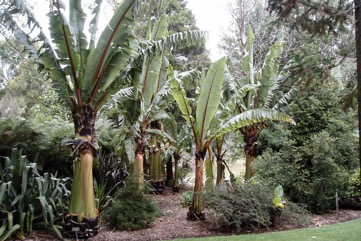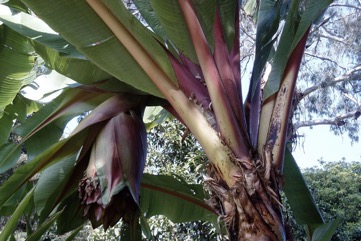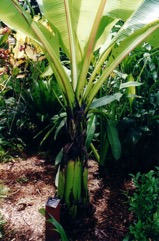Ensete

It grows in tropical Africa. It does best with a temperature of 18-28°C and a relative humidity of 60-80 %. In Ethiopia it grows between 1500 and 3000 m altitude but does best between 1700 and 2450 m altitude. In Malawi it is usually on the edges of forests or in sheltered gullies. It is damaged by frost or drought. It can grow in arid places. In the Cairns Botanical Gardens. It suits hardiness zones 10-12.
Also known as:
Abyssinian banana, Bananeira selvagem, Chizuzu, Echecha, Enset, Hovha, Ihindu, Inset, Inteembeteembe, Kitembe, Koba, Latembe, Linyimbili, Magao, Mgomba pori, Olek, Ol-musalala, Sasuriet, Shwe-nget-pyaw, Tambwe, Warqee, Workem
Synonyms
- Ensete edule (J. F. Gmel.) Bruce ex Horan.
- Ensete davyae (Stapf.) Cheesman
- Ensete arnoldianum (De Wild.) Cheesman
- Ensete bagshawei (Rendle & Greaves) Cheesman
- Ensete buchananii (Baker) Cheesman
- Ensete fecundum (Stapf) Cheesman
- Ensete ruandense (De Wild.) Cheesman
- Ensete rubronervatum (De Wild.) Cheesman
- Ensete schweinfurthii (K. Schum. & Warb.) Cheesman
- Ensete ulugurense (Warb.) Cheesman
- Ensete ventricosum (Welw.) Cheesman var. montbeliardii (Bois) Cufod
- Ensete holstii (K. Schum.) Cheesman
- Ensete laurentii (De Wild.) Cheesman
- Ensete proboscideum (Oliv.) Cheesman
- Musa arnoldiana De Wild.
- Musa bagshawei Rendle & Greaves
- Musa buchananii Baker
- Musa davyae Stapf.
- Musa ensete J. F. Gmel.
- Musa ensete J. F. Gmel. var. montbeliardii Bois
- Musa fecunda Stapf
- Musa holstii K. Schum.
- Musa laurentii De Wild.
- Musa proboscidea Oliv.
- Musa ruandensis De Wild.
- Musa rubronervata De Wild.
- Musa schweinfurthii K. Schum.
- Musa ulugurensis Warb.
- Musa ventricosa Welw.
Edible Portion
- Leaves, Stem, Seeds, Corm, Flower heads, Rootstock, Rhizome, Vegetable
Where does Ensete grow?
Found in: Africa, Angola, Asia, Australia, Angola, Burundi, Cameroon, Central Africa, Congo, East Africa, Ethiopia, Guatemala, India, Indonesia, Kenya, Malawi, Mozambique, Myanmar, Pacific, Philippines, Rwanda, Sao Tome and Principe, SE Asia, South Africa, Southern Africa, Sudan, Tanzania, Uganda, West Africa, Zambia, Zimbabwe
Notes: There are 10 Ensete species.
Status: In areas with an ensete staple between 0.5-0.7 kg of kocho are eaten per person per day. This provides about 860-1400 calories. It is a staple food for 10 million people.
Growing Ensete
Cultivation: It can be grown by seed. It is normally grown by bud suckers or shoots. To get bud suckers a 4-6 year old plant is cut off at 20-30 cm height. The central bud (which would normally grow one shoot) is removed and the hole filled with soil. The corm is then replanted into a manured pit about 5 days later. After 4-8 weeks this produces 40-200 buds. These can be separated and grown in a nursery for one year before being transplanted into the field. These plants are normally then transplanted to wider spacing after 2 then 4 years. Plants reach harvest maturity in 6-7 years. Suckers can be used for transplanting and reach maturity in 2 years. The final spacing for bud suckers is 3 m x 1.5 m. Large amounts of organic manure are often applied. Plants are harvested before the onset of flowering.
Edible Uses: The fermented pulp (kocho) of the stem is eaten. It is used as a flour to make bread. The leaf bases and fresh corms are cut up and boiled as a vegetable. The milky white juice extract is allowed to ferment in pits lined with ensete leaves then cooked. The young flowers are eaten as a relish. The fruit are eaten only in times of food scarcity. It is the endosperm of the seeds that is eaten.
Production: An average family cultivates 200-400 plants per year and they eat about 10-20 plants per person per year. In Ethiopia using1600 plants per hectare at a spacing of 2.5 m gave about 5000 kg per hectare of refined product.
Nutrition Info
per 100g edible portion| Edible Part | Energy (kcal) | Protein (g) | Iron (mg) | Vitamin A (ug) | Vitamin c (mg) | Zinc (mg) | % Water |
|---|---|---|---|---|---|---|---|
| Pith | 171 | 1.2 | 5.3 | - | - | - | 56.3 |
| Seed dry | 352 | 13.3 | - | - | - | - | 12.4 |
Ensete Photos



References
Allen, D. J., 2007, Wildflowers and Common Trees of East Africa. Camerapix Publishers p 170
Ambasta, S.P. (Ed.), 2000, The Useful Plants of India. CSIR India. p 196
Asfaw, Z., Conservation and use of traditional vegetables in Ethiopia. FAO
Bekele-Tesemma A., Birnie, A., & Tengnas, B., 1993, Useful Trees and Shrubs for Ethiopia. Regional Soil Conservation Unit. Technical Handbook No 5. p 210
Berihun, T. & Molla, E., 2017, Study on the Diversity and Use of Wild Edible Plants in Bullen District Northwest Ethiopia. Hindawi Journal of Botany. Article ID 8383468
Bodkin, F., 1991, Encyclopedia Botanica. Cornstalk publishing, p 381
Brickell, C. (Ed.), 1999, The Royal Horticultural Society A-Z Encyclopedia of Garden Plants. Convent Garden Books. p 397
Coronel, R.E., 1982, Fruit Collections in the Philippines. IBPGR Newsletter p 6
Cundall, P., (ed.), 2004, Gardening Australia: flora: the gardener's bible. ABC Books. p 538
Dharani, N., 2002, Field Guide to common Trees & Shrubs of East Africa. Struik. p 91
Etherington, K., & Imwold, D., (Eds), 2001, Botanica's Trees & Shrubs. The illustrated A-Z of over 8500 trees and shrubs. Random House, Australia. p 279
Facciola, S., 1998, Cornucopia 2: a Source Book of Edible Plants. Kampong Publications, p 156
FAO, 1988, Traditional Food Plants, FAO Food and Nutrition Paper 42. FAO Rome p 269
Fowler, D. G., 2007, Zambian Plants: Their Vernacular Names and Uses. Kew. p 86
Fox, F. W. & Young, M. E. N., 1982, Food from the Veld. Delta Books. p 275
Grubben, G. J. H. and Denton, O. A. (eds), 2004, Plant Resources of Tropical Africa 2. Vegetables. PROTA, Wageningen, Netherlands. p 561
Hedrick, U.P., 1919, (Ed.), Sturtevant's edible plants of the world. p 424 (As Musa ensete)
Heywood, V.H., Brummitt, R.K., Culham, A., and Seberg, O., 2007, Flowering Plant Families of the World. Royal Botanical Gardens, Kew. p 382
Jardin, C., 1970, List of Foods Used In Africa, FAO Nutrition Information Document Series No 2.p 15, 42, 76
Joffe, P., 2007, Creative Gardening with Indigenous Plants. A South African Guide. Briza. p 226
Kew Bull. 2:101. 1948
Kiple, K.F. & Ornelas, K.C., (eds), 2000, The Cambridge World History of Food. CUP p 1772 (As Musa ensete)
Lim, T. K., 2015, Edible Medicinal and Non Medicinal Plants. Volume 9, Modified Stems, Roots, Bulbs. Springer p 41
Lovett, J. C. et al, Field Guide to the Moist Forest Trees of Tanzania. p 182
Martin, F.W. & Ruberte, R.M., 1979, Edible Leaves of the Tropics. Antillian College Press, Mayaguez, Puerto Rico. p 206
Mengistu, F. & Hager, H., 2008, Wild Edible Fruit Species Cultural Domain, Informant Species Competence and Preference in Three Districts of Amhara Region, Ethiopia. Ethnobotany Research & Applications 6:487-502
Molla, A., Ethiopian Plant Names. http://www.ethiopic.com/aplants.htm (As Ensete edulis)
Msola, D. K., 2007, The role of Wild Foods in Household Income and Food Security in Mufundi District, Tanzania. Morogoro, Tanzania. p 46
Nzigidahera, B., 2006, Assessment of Socio-cultural, Economic Characteristics and Livelihood of Riparian Population of the Kibira National Park. (Rukoma-Mutana locality). UNDP p 30
Okigbo, B.N., Vegetables in Tropical Africa, in Opena, R.T. & Kyomo, M.L., 1990, Vegetable Research and development in SADCC countries. Asian Vegetable Research and development Centre. Taiwan. p 44
Olango, T. M., et al, 2014, Indigenous knowledge, use and on-farm management of enset (Ensete ventricosum (Welw.) Cheesman) diversity in Wolaita, Southern Ethiopia. Journal of Ethnobiology and Ethnomedicine, 10:41
Oryema, C., et al, 2013, Edible wild fruit species of Gulu District, Uganda. International Journal of Biology and Biological Sciences Vol 2(4) pp 068-082
Palgrave, K.C., 1996, Trees of Southern Africa. Struik Publishers. p 88
Palmer, E and Pitman, N., 1972, Trees of Southern Africa. Vol. 1. A.A. Balkema, Cape Town p 403
Peters, C. R., O'Brien, E. M., and Drummond, R.B., 1992, Edible Wild plants of Sub-saharan Africa. Kew. p 36
Plants for a Future database, The Field, Penpol, Lostwithiel, Cornwall, PL22 0NG, UK. http://www.scs.leeds.ac.uk/pfaf/
Plowes, N. J. & Taylor, F. W., 1997, The Processing of Indigenous Fruits and other Wildfoods of Southern Africa. in Smartt, L. & Haq. (Eds) Domestication, Production and Utilization of New Crops. ICUC p 190
Purseglove, J. W., 1972, Tropical Crops. Monocotyledons. Longmans p 344
Regassa, T., et al, 2014, Ethnobotany of Wild and Semi-Wild Edible Plants of Chelia District, West-Central Ethiopia. Science, Technology and Arts Research Journal. 3(4): 122-134
Royal Botanic Gardens, Kew (1999). Survey of Economic Plants for Arid and Semi-Arid Lands (SEPASAL) database. Published on the Internet; http://www.rbgkew.org.uk/ceb/sepasal/internet [Accessed 4th May 2011]
Ruiters-Welcome, A. K., 2019, Food plants of southern Africa. Ph.D. thesis. Univ. of Johannesburg p 80
Smith, N., Mori, S.A., et al, 2004, Flowering Plants of the Neotropics. Princeton. p 463
Tsegaye, A. & Westphal, E., 2002. Ensete ventricosum (Welw.) Cheesman. [Internet] Record from Protabase. Oyen, L.P.A. & Lemmens, R.H.M.J. (Editors). PROTA (Plant Resources of Tropical Africa), Wageningen, Netherlands. < http://database.prota.org/search.htm>. Accessed 16 October 2009.
van Wyk, B, van Wyk, P, and van Wyk B., 2000, Photographic guide to Trees of Southern Africa. Briza. p 132
van Wyk, B., 2005, Food Plants of the World. An illustrated guide. Timber press. p 188
Vickery, M.L. and Vickery, B., 1979, Plant Products of Tropical Africa, Macmillan. p 36
White, F., Dowsett-Lemaire, F. and Chapman, J. D., 2001, Evergreen Forest Flora of Malawi. Kew. p 103
Williamson, J., 2005, Useful Plants of Malawi. 3rd. Edition. Mdadzi Book Trust. p 108
World Checklist of Useful Plant Species 2020. Royal Botanic Gardens, Kew
www.zimbabweflora.co.zw 2011